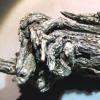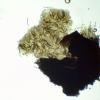
24-12-2025 17:08
Hulda Caroline HolteHello, I have found this propoloid ascomycete on

21-12-2025 09:32
Hello.A tiny ascomycete found embedded in wood in

21-12-2025 21:32
Pol DebaenstHello, Garden, Burgweg 19, Veurne, BelgiumOn 10/1

22-12-2025 23:38
Patrice TANCHAUDBonsoir, récolte sur un mur en pierre, apothéci

22-12-2025 00:47
Patrice TANCHAUDBonsoir, récolte à proximité du milieu dunaire
Pleospora?
Martin Bemmann,
24-04-2010 23:35
 Hello,
Hello,this one I collected nearly one year ago (in May 2009) in northern Pakistan near Gilgit. It grows on a dead stem of Artemisia. The climate there is extremely dry and hot, a high mountain desert.
Today I rehydrated a portion and started to study it. I don't have much experience with exsiccated material, but I was astonished how fresh it looked.
Martin Bemmann,
24-04-2010 23:42

Re:Pleospora?
The IKI reaction of the asci is negative. Size is 130-171x12-15 µm.
I found no free spores, so I measured those that appeared to be +/- mature within the asci: 21-31x9-12 µm.
Paraphyses are very thin and filiforme with small oildrops.
Would Pleospora be an option for the genus?
PS: all micros in tap-water...
Cheers,
Martin
I found no free spores, so I measured those that appeared to be +/- mature within the asci: 21-31x9-12 µm.
Paraphyses are very thin and filiforme with small oildrops.
Would Pleospora be an option for the genus?
PS: all micros in tap-water...
Cheers,
Martin
Hans-Otto Baral,
25-04-2010 09:03

Re:Pleospora?
Hi Martin
I have a lot of photos of various collections of such fungi from semideserts. They are quite frequent but I have no name for any of them.
Here is one as an example:
Mongolei, Lonicera microphylla, leg. P. Karasch. Perith. 0.4-0.7 mm diam., scattered. Sp. *23-26 x 11.5-12 µm.
I usually use the name Teichospora for them, but I am completely unaware of how to delimit the genera Teichospora, pleospora, Cucurbitaria etc.
Here is also one, for which I got no reponse:
http://www.ascofrance.fr/index.php?r=forum&page=viewtopic&id=8953&highlight=teichospora#msg8953
Zotto
I have a lot of photos of various collections of such fungi from semideserts. They are quite frequent but I have no name for any of them.
Here is one as an example:
Mongolei, Lonicera microphylla, leg. P. Karasch. Perith. 0.4-0.7 mm diam., scattered. Sp. *23-26 x 11.5-12 µm.
I usually use the name Teichospora for them, but I am completely unaware of how to delimit the genera Teichospora, pleospora, Cucurbitaria etc.
Here is also one, for which I got no reponse:
http://www.ascofrance.fr/index.php?r=forum&page=viewtopic&id=8953&highlight=teichospora#msg8953
Zotto
Jacques Fournier,
25-04-2010 09:06

Re:Pleospora?
Hi Martin,
I feel you are not expecting a name for your fungus, it's wise!
The cylindric asci with uniseriate spores are not typical of species currently regarded as Pleospora. Furthermore, pseudoparaphyses in this genus are usually cellular, that is rather wide, 2-3 µm, and septate.
Pleosporales are currently in a terrible mess because none of the morphological characters formerly used to delimit genera proved relevant according to molecular data.
Collected material needs to be described, cultured and sequenced until things are hopefully sorted out with time.
Cheers,
Jacques
I feel you are not expecting a name for your fungus, it's wise!
The cylindric asci with uniseriate spores are not typical of species currently regarded as Pleospora. Furthermore, pseudoparaphyses in this genus are usually cellular, that is rather wide, 2-3 µm, and septate.
Pleosporales are currently in a terrible mess because none of the morphological characters formerly used to delimit genera proved relevant according to molecular data.
Collected material needs to be described, cultured and sequenced until things are hopefully sorted out with time.
Cheers,
Jacques
Martin Bemmann,
25-04-2010 09:28

Re:Pleospora?
Dear Zotto and Jaques,
Thank you for your comments! I was already overwhelmed when I saw the number of plates in Berlese with Pleospora and similar fungi and the number of pages of Wehmeyer's monography. Reading the key in Crivelli's thesis I got hopeless.....
I will put back this specimen into my small herbar-box and devote my limited time to more promising collections. ;-)
Best regards,
Martin
Thank you for your comments! I was already overwhelmed when I saw the number of plates in Berlese with Pleospora and similar fungi and the number of pages of Wehmeyer's monography. Reading the key in Crivelli's thesis I got hopeless.....
I will put back this specimen into my small herbar-box and devote my limited time to more promising collections. ;-)
Best regards,
Martin
Xavier LLIMONA,
26-04-2010 12:48
Re:Pleospora?
Il faudrait regarder du côté de Lophiostoma compressum. En tout cas, il s'agit d'une espèce de "champignon drosophile", un groupe écologique, formé surtout de bituniqués, qui poussent sur le bois, en regardant vers le ciel, d'òu leur arrive la rosée nocturne. En anglais, je les appellerai "dew loving fungi". Très fréquents dans le SE de l'Espagne et aussi tout le long de l'aride vallée de l'Ebre.
Je vous recommande vivement de consulter: Dolores SIERRA 2006 Contribución al estudio de los Ascomicetes Bitunicados de Cataluña Acta Bot. Barc. 50:5-434. Il s'agit d'une très belle thèse doctorale. Il nous en reste quelques exemplaires, mais l'ouvrage est disponible on-line sur http://bibdigital.rjb.csic.es/spa/index.php
Je vous recommande vivement de consulter: Dolores SIERRA 2006 Contribución al estudio de los Ascomicetes Bitunicados de Cataluña Acta Bot. Barc. 50:5-434. Il s'agit d'une très belle thèse doctorale. Il nous en reste quelques exemplaires, mais l'ouvrage est disponible on-line sur http://bibdigital.rjb.csic.es/spa/index.php
Jacques Fournier,
26-04-2010 13:45

Re:Pleospora?
merci Xavier pour ces intéressantes réflexions.
La thèse de Dolores Sierra est effectivement une contribution impressionnante, merci de nous l'avoir fait connaître.
Je l'ai trouvée à l'adresse suivante:
http://www.raco.cat/index.php/ActaBotanica/article/viewFile/59858/102516
Amitiés,
Jacques
La thèse de Dolores Sierra est effectivement une contribution impressionnante, merci de nous l'avoir fait connaître.
Je l'ai trouvée à l'adresse suivante:
http://www.raco.cat/index.php/ActaBotanica/article/viewFile/59858/102516
Amitiés,
Jacques
Martin Bemmann,
26-04-2010 18:53

Re:Pleospora?
Hi Xavier!
Thank you for your proposal Lophiostoma compressum and for pointing me to this interesting thesis!
But I am not happy with L.c. (beeing far from to be familiar with this order or even family of fungi).
If you compare, you will find much differences. I will show you some old beautiful illustrations:
Here is Saccardo's Lophiostoma (Lophidium) compressum:
Thank you for your proposal Lophiostoma compressum and for pointing me to this interesting thesis!
But I am not happy with L.c. (beeing far from to be familiar with this order or even family of fungi).
If you compare, you will find much differences. I will show you some old beautiful illustrations:
Here is Saccardo's Lophiostoma (Lophidium) compressum:
Martin Bemmann,
26-04-2010 19:03

Re:Pleospora?
in both cases the ostioles are very prominent and spatulate. The asci are smaller and the spores have very acute ends, features I can't observe with my material.
When I look to the plate in the thesis of Sierra Lopez (fig. 9, p. 139) this would fit better, as well as asci and spore size. I wonder why it looks so different from that what Saccardo and Berlese ment to be L.c.
Best regards,
Martin
When I look to the plate in the thesis of Sierra Lopez (fig. 9, p. 139) this would fit better, as well as asci and spore size. I wonder why it looks so different from that what Saccardo and Berlese ment to be L.c.
Best regards,
Martin







